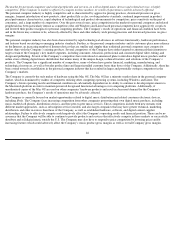Apple 2005 Annual Report Download - page 57
Download and view the complete annual report
Please find page 57 of the 2005 Apple annual report below. You can navigate through the pages in the report by either clicking on the pages listed below, or by using the keyword search tool below to find specific information within the annual report.
the Company’s key employees are located. The Company has relied on its ability to grant stock options as one mechanism for recruiting and
retaining this highly skilled talent. Recent accounting regulations requiring the expensing of stock options will impair the Company’s future
ability to provide these incentives without incurring significant compensation costs. There can be no assurance that the Company will continue
to successfully attract and retain key personnel.
The Company is subject to risks associated with the selection, availability, and cost of insurance.
The Company has observed rapidly changing conditions in the insurance markets relating to nearly all areas of traditional commercial
insurance. Such conditions have and may continue to result in higher premium costs, higher policy deductibles, lower coverage limits and may
also yield possible policy form exclusions. For some risks, because of cost and/or availability, the Company does not have insurance coverage.
Because the Company retains some portion of its insurable risks, and in some cases self insures completely, unforeseen or catastrophic losses in
excess of insured limits may have a material adverse effect on the Company’s results of operations and financial position.
Failure of information technology systems and breaches in the security of data upon which the Company relies could adversely affect the
Company’s future operating results.
Information technology system failures and breaches of data security could disrupt the Company’s ability to function in the normal course of
business by potentially causing delays or cancellation of customer orders, impeding the manufacture or shipment of products, or resulting in the
unintentional disclosure of customer or Company information. Management has taken steps to address these concerns for its own systems by
implementing sophisticated network security and internal control measures. However, there can be no assurance that a system failure or data
security breach of the Company or a third-party vendor will not have a material adverse effect on the Company’s results of operations.
The Company’s business is subject to the risks of international operations.
A large portion of the Company’s revenue is derived from its international operations. As a result, the Company’s operating results and
financial condition could be significantly affected by risks associated with international activities, including economic and labor conditions,
political instability, tax laws (including U.S. taxes on foreign subsidiaries), and changes in the value of the U.S. dollar versus the local currency
in which the products are sold and goods and services are purchased. The Company’s primary exposure to movements in foreign currency
exchange rates relate to non-dollar denominated sales in Europe, Japan, Australia, Canada, and certain parts of Asia and non-dollar
denominated operating expenses incurred throughout the world. Weaknesses in foreign currencies, particularly the Japanese Yen and the Euro,
can adversely impact consumer demand for the Company’s products and the U.S. dollar value of the Company’s foreign currency denominated
sales. Conversely, a strengthening in these and other foreign currencies can cause the Company to modify international pricing and affect the
value of the Company’s foreign denominated sales, and in some cases, may also increase the cost to the Company of some product
components.
Margins on sales of the Company’s products in foreign countries, and on sales of products that include components obtained from foreign
suppliers, can be adversely affected by foreign currency exchange rate fluctuations and by international trade regulations, including tariffs and
antidumping penalties.
Derivative instruments, such as foreign exchange forward and option positions have been utilized by the Company to hedge exposures to
fluctuations in foreign currency exchange rates. The use of such hedging activities may not offset more than a portion of the adverse financial
impact resulting from unfavorable movements in foreign exchange rates.
55
























